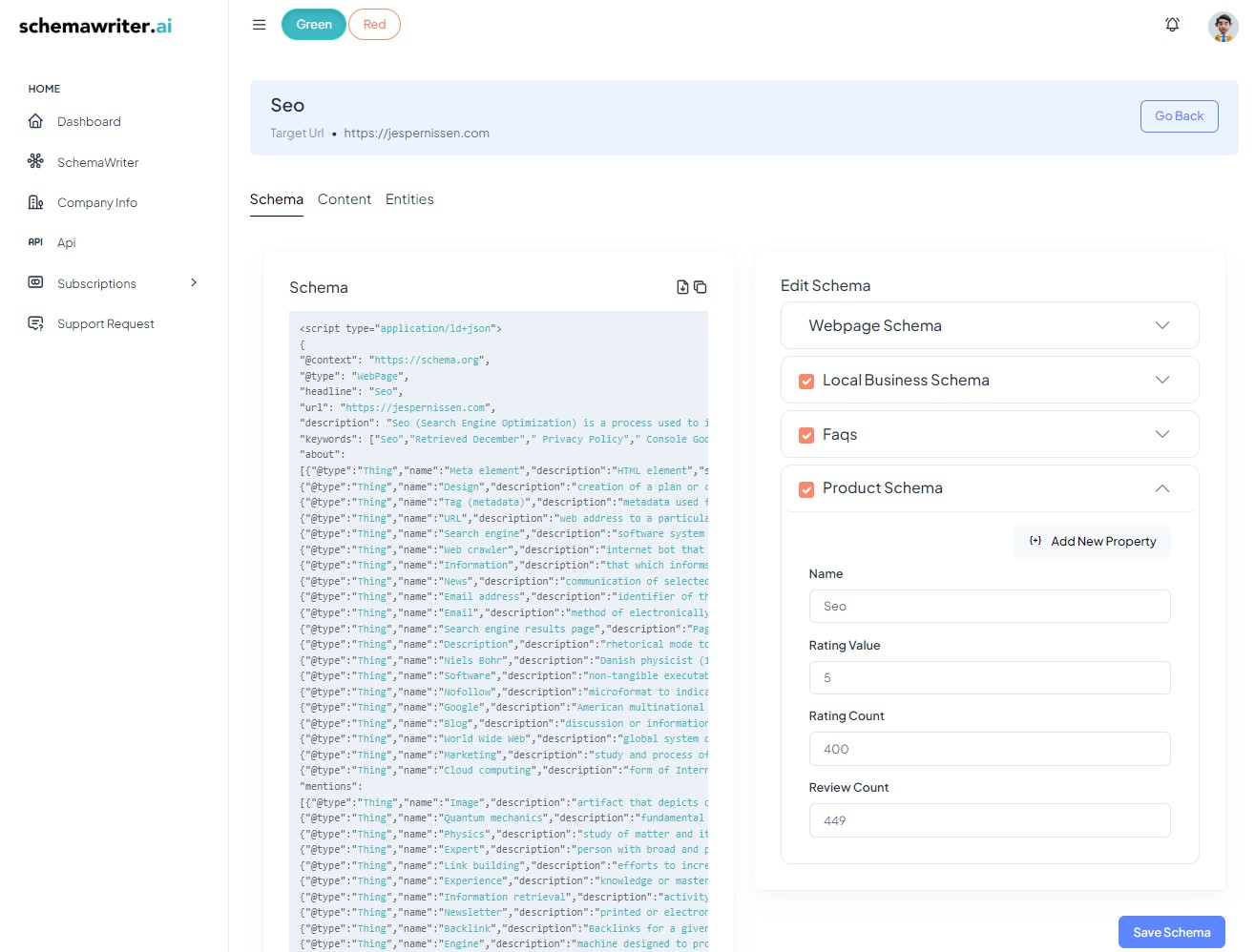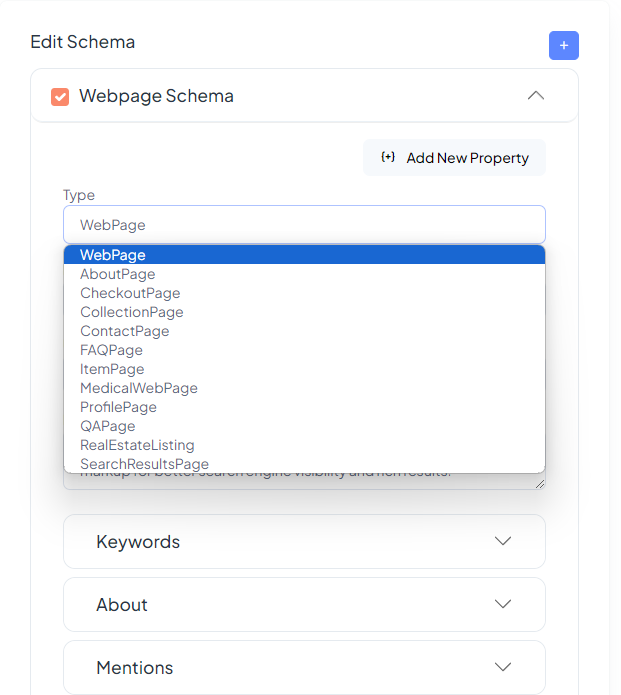Webpage schema generator
– fully automated
Webpage schema generation on autopilot: schemawriter.ai creates the complete web page schema you need to markup the content on your webpages. This includes keywords, entities, text descriptions of the topics of your page, and other relevant information. Use the schema code on your backlinks for extra power.

Timesaving automated schema writing
Schemawriter.ai writes all of the schema code for you. No errors. We have spent countless off hours on implementing our handwritten schema templates. This gives you the best of both worlds. Thoroughly researched schema files, and schema code that validates. The built in georadius schema generator is also based on research into local seo ranking factors.
What is webpage schema
The webpage schema marks up all the content on a webpage. Its the most fundamental schema type to be used on a web page. All other schema types, for example video schema and image schema are included as items under the webpage schema. The about, mentions and keywords are used to explain to the search engines what topics that the webpage is about. Check the full definition for webpage schema in schema.org. When doing digital marketing, proper webpage schema is essential to get results.
Webpage schema example from schemawriter.ai
Besides the above fields, we have implemented automation of the about, mentions, and description fields. A webpage schema example from schemawriter.ai could look like this:
<script type="application/ld+json">
{
"@id": "https://schemawriter.ai#webpage",
"@context": "https://schema.org",
"@type": "WebPage",
"headline": "Webpage schema",
"url": "https://schemawriter.ai",
"description": "Optimize your sites SEO with structured webpage schema markup for enhanced search engine visibility and rich results.",
"keywords": ["Webpage schema","Schema Markup","schema","markup","Google","search results","CreativeWork","structured data","web page","Schema Generator"],
"about":
[{"@type":"Thing","name":"Schema.org","description":"project to create, maintain, and promote schemas for structured data on the Internet, on web pages, in email messages, and beyond","sameAs":["https://en.wikipedia.org/wiki/Schema.org","https://www.wikidata.org/wiki/Q3475322","https://www.google.com/search?q=Schema.org&kgmid=/m/0gvvdn9"]},
{"@type":"Thing","name":"Website wireframe","description":"visual guide that represents the skeletal framework of a website","sameAs":["https://en.wikipedia.org/wiki/Website_wireframe","https://www.wikidata.org/wiki/Q3045202","https://www.google.com/search?q=Website+wireframe&kgmid=/m/05qbjt"]},
{"@type":"Thing","name":"Web design","description":"creation and maintenance of websites","sameAs":["https://en.wikipedia.org/wiki/Web_design","https://www.wikidata.org/wiki/Q190637","https://www.google.com/search?q=Web+design&kgmid=/m/086df"]},
{"@type":"Thing","name":"Site map","description":"list of pages of a web site","sameAs":["https://en.wikipedia.org/wiki/Site_map","https://www.wikidata.org/wiki/Q1503327","https://www.google.com/search?q=Site+map&kgmid=/m/07mflw"]}],
"mentions":
[{"@type":"Thing","name":"computer program","description":"sequence of instructions written in programming language to perform a specified task with a computer","sameAs":["https://en.wikipedia.org/wiki/Computer_program","https://www.wikidata.org/wiki/Q40056","https://www.google.com/search?q=computer+program&kgmid=/m/01r9v"]},
{"@type":"Thing","name":"backlinks","description":"links from some other website (the referrer) to that web resource (the referent)","sameAs":["https://en.wikipedia.org/wiki/Backlink","https://www.wikidata.org/wiki/Q373952","https://www.google.com/search?q=backlinks&kgmid=/m/02s3gg"]},
{"@type":"Thing","name":"algorithm","description":"sequence of instructions to perform a task","sameAs":["https://en.wikipedia.org/wiki/Algorithm","https://www.wikidata.org/wiki/Q8366","https://www.google.com/search?q=algorithm&kgmid=/m/0jpv"]},
{"@type":"Thing","name":"computer programming","description":"the process of designing and building an executable computer program to accomplish a specific computing result or to perform a specific task","sameAs":["https://en.wikipedia.org/wiki/Computer_programming","https://www.wikidata.org/wiki/Q80006","https://www.google.com/search?q=computer+programming&kgmid=/m/01mf_"]}]
}
</script>

Complete webpage schema in 2 minutes
It takes 2 minutes to run a report, and you get several hundreds of code lines. Writing a couple of hundred of schema lines in hand takes several hours of back and forth between your code editor and schema.org validation tool.
You can create a report for up to 3 keywords at a time, allowing you to generate a schema report with entities for multiple search queries.
Using the Google search api, we allow you to select what country you want to search from, and we support up to 17 languages natively, when it comes to entity recognition.
You determine if you want schemawriter to select your competitors, or you can select your own competitors to scan and analyze. We employ our web scraping technology, and analyze up to 10 competitors for entities and YAKE keywords.
You have 4 options to determine how many entities to have by default, but this is also customizable. The AUTO option mixes your own detected entites, with the entities that Google prefer.
12 types of webpage schema
From the definition for webpage schema in schema.org, there are the following 12 types of webpage that we support. Its simple to change type of webpage schema, you just click on the dropdown and select your type:
- WebPage – the default webpage schema type. All below types are subtypes of webpage schema.
- AboutPage – this is typically used on the About us page to describe the organization.
- CheckoutPage – a schema type used in ecommerce. The checkoutpage schema type can be used in a webshops checkout page.
- CollectionPage – this can be used for example on a category page with links to pages or products.
- ContactPage – used on the contact page. Its used to inform the search engines of the contact information of the company or organization.
- FAQPage – this is the next most comming webpage schema type. FAQpage is used in a page to markup frequently asked questions and answers. It can be combined with the webpage schema type, if you have questions present on the page you are marking up with schema.
- ItemPage – is used in ecommerce to markup a page with a lot of similar items or products.
- MedicalWebPage – used to markup medical content or products. Its used on a webpage that contain information about health or medicla topics.
- ProfilePage – this is used to describe the author or creator of a website. It can for example be used on affiliate or test sites, where creators share firsthand experience, and they have seperate author pages.
- QAPage – this is used to markup a page that has questions and their corresponding answers. According to Google documentation, users has to be able to submit answers to questions, in order for this schema type to be valid.
- RealEstateListing – this is used on a page that describes one or more real-estate offers.
- SearchResultsPage – used to markup a page dedicated to show search results from the search funtion on your webpage. Typically used in ecommerce.

Webpage schema features
We use more than 10 APIs to be able to scan competitors, fetch entities detect and deliver the correct WIKI urls and Google Knowledge Panel machine IDS for the webpage schema reports.
Openai integration
Openai is used to produce content for text fields throughout the schemawriter platform. We combine the entities and YAKE keywords, and use the OpenAI to produce relevant content. Its currently used in the webpage schema in the description.
Identification of relevant entities
When running the report, you enter your target keyword, target url and your competitors. You can choose your own competitor websites to crawl, or let the tool do it for you. The software will scrape the top competitor websites and your own website and produce a very large list of entities.
Entity filter
We have developed an advanced entity filter, which allow the software to detect and automatically insert the entities in the about and mentions section of the webpage schema. The entities we insert, are the ones with the highest topical correlation to the target keyword you want the page to rank for.
Wikipedia and Wikidata integration
For all entities we detect, we find the corresponding Wikipedia and Wikidata URL. We insert these urls in the sameAs section for the particular entity. The reason for this is, we give Google and other search engines the unambiguous definition of the entity. This helps with the search engines understanding when they are crawling the webpage.
Google search api for correct identification of competitor websites
We use the Google Search API to identify your competitors websites. The advantage of using Google Search API is, it allows us to use Googles own internal engine to deliver to correct search results. It also allows you to determine the country from where you are searching, so you get the correct competitor websites, based on your own country search results.
YAKE keywords detection and insertion
We detect the YAKE keywords from your and your competitors websites and insert them in the keywords section in the webpage schema. The keywords section is used to inform the search engines of related keywords that your webpage is about.
What are the YAKE keywords?
The YAKE keywords are the keywords that are not entities, but are still topically relevant to the search term, that you create the webpage schema for. By including the YAKE keywords in the content and schema, your chance to rank for your search term increases, as it helps the search engines tie the content together.
Whats does the standard webpage schema look like?
The standard webpage schema contain this code as a minimum:
<script type="application/ld+json">
{
"@id": "https://schemawriter.ai#webpage",
"@context": "https://schema.org",
"@type": "WebPage",
"headline": "Webpage schema",
"url": "https://schemawriter.ai",
"description": "Implement structured Webpage schema to enhance SEO and improve visibility in search engine results.",
}
</script>
Why is it important to include schema markup on a webpage?
Including schema markup on a webpage is important, because it enables search engines to understand the content on your webpages. This can lead to enhanced search engine visibility, rich snippets in search results (like ratings, images, or event information), and potentially higher click-through rates.
How do you implement schema markup on your websites pages?
Schema markup is implemented by adding the schema code to the head section of the html of your webpage. If you use WordPress, use a plugin like HFCM to manage your code snippets.
What types of information can be represented with webpage schema?
The webpage schema can represent the content of your page, image, videos, questions and answers and much more. Each type has specific properties that help describe its unique characteristics.
Can implementing schema impact my websites SEO performance?
Yes for sure. When you use schemawriter to identify the entities and keywords and include them in your schema code, you will provide Google and other search engines with detailed knowledge of your webpage. We have seen this to impact the rankings positively in many cases across many niches.

